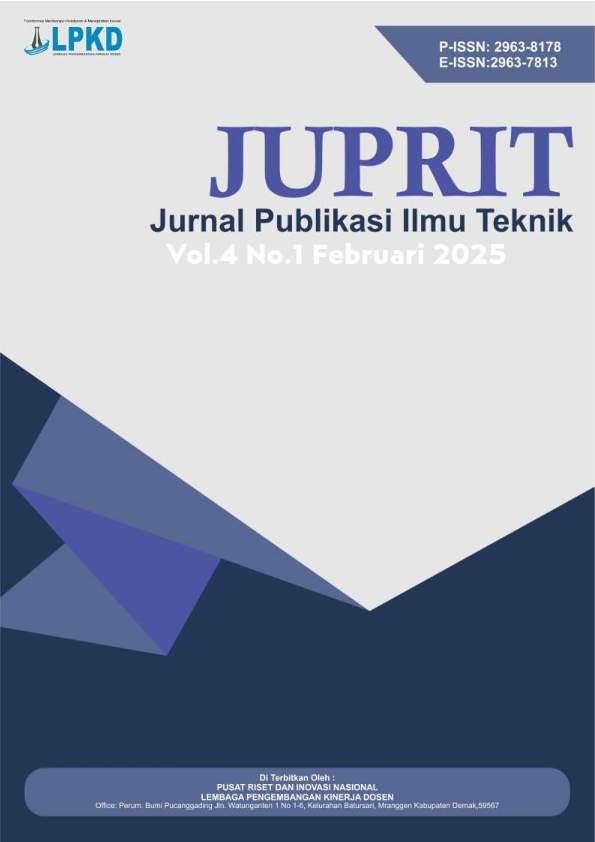Penerapan Model Pembelajaran Teaching Factory (TEFA) pada Materi Konsep Dasar Kelistrikan Sepeda Motor Terhadap Hasil Belajar Siswa Kelas XI TBSM SMK Negeri 1 Nisam
DOI:
https://doi.org/10.55606/juprit.v4i1.4846Keywords:
Teaching Factory, Student Learning Outcomes, Basic Concepts of Motorcycle ElectricityAbstract
This research aims to find out: (1) Improvement in student learning outcomes, (2) Student responses, (3) Find out whether there is an increase in student and teacher activity, after implementing the taching factory learning model on basic electrical concepts material in class XI TBSM SMK Negeri 1 Nisam. The type of research used is Quasi Experimental Design using a non-equivalent control design. The sampling technique used was 40 students consisting of 20 class XI TBSM 2 students as the experimental class and 20 TBSM 1 students as the control class. Data collection instruments use multiple choice questions and questionnaires. The research results show that: (1) There is an increase in student learning outcomes after implementing the teaching factory learning model on basic motorbike electrical concept material with an average n-gain score for the experimental class of 0.70, which is in the medium category, in the control class the average is n -gain score of 0.16 is in the low category. (2) Student response questionnaire after applying the teaching factory learning model to the basic concepts of motorbike electricity in class XI TBSM SMK Negeri 1 Nisam is in the very good category with an average score of 83%. (3) teacher activities are in the good category with an overall average score of 3.42 with a percentage of 85.5%, while student activities are in the good category with an overall average score of 3.33 with a percentage score of 83%.
Downloads
References
Agus, A. (2023). Aplikasi model pembelajaran teaching factory untuk meningkatkan minat dan hasil belajar siswa pelajaran pre di SMK Negeri 3 Selong. ACADEMIA: Jurnal Inovasi Riset Akademik, 3(2), 126–133. https://doi.org/10.51878/academia.v3i2.2344
Anas, A., & Mujahidin, E. (2022). Implementasi konsep 4C dalam pembelajaran pada mata kuliah analisis kebijakan pendidikan. Tadbiruna, 2(1), 1–13. https://doi.org/10.51192/tadbiruna.v2i1.356
Aziizu, B. Y. A. (2015). Tujuan besar pendidikan adalah tindakan. Prosiding Penelitian dan Pengabdian kepada Masyarakat, 2(2), 295–300. https://doi.org/10.24198/jppm.v2i2.13540
Delvi, F. (2022). Pengaruh sarana prasarana pendidikan dan lingkungan keluarga terhadap hasil belajar di SD 023 Teluk Binjai Dumai. Jurnal Tadzakkur, 2(1), 51–61. https://doi.org/10.57113/taz.v2i1.123
Djalal, F. (2017). Optimalisasi pembelajaran melalui pendekatan, strategi, dan model pembelajaran. Jurnal Dharmawangsa, 2(1), 31–52.
Fatmawati, K., Kusdiyanti, H., & Sumarsono, H. (2023). The effect of entrepreneurial education and experiential learning on entrepreneurial intention mediated by teaching factory (TEFA). International Education Trend Issues, 1(3), 285–301.
Fatwa, I., Larosa, E., & Absa, M. (2023). Penerapan model pembelajaran PBL untuk meningkatkan hasil belajar siswa TPBO SMK 2 Depok. Jurnal Pendidikan dan Profesi Keguruan, 4(2), 97–104. https://doi.org/10.59562/progresif.v3i1.30695
Fauzi, N. R., & Sisilia, K. (2020). Analisis perbandingan keputusan pembelian online dan offline customer pada OR-K 689 Clothing. Jurnal Menara Ekonomi: Penelitian dan Kajian Ilmiah Bidang Ekonomi, 6(2), 37. https://doi.org/10.31869/me.v6i2.1812
Firmansyah, & Penelaah, E. A. (2022). Dasar-dasar teknik (Weni Rahay).
Gozali, G., Dardiri, A., & Soekopitojo, S. (2018). Penerapan teaching factory jasa boga untuk meningkatkan kompetensi entrepreneur siswa sekolah menengah kejuruan. JSHP (Jurnal Sosial Humaniora dan Pendidikan), 2(1), 46. https://doi.org/10.32487/jshp.v2i1.264
Jamil, H., & Indra Azra, F. (2015). Pengaruh lingkungan keluarga dan motivasi belajar siswa terhadap hasil belajar akuntansi siswa kelas X SMK Negeri 1 Solok Selatan. Economica, 2(2), 85–98. https://doi.org/10.22202/economica.2014.v2.i2.221
Kurnianto, B., & Arsana, I. M. (2020). Penerapan pembelajaran problem based learning untuk meningkatkan kemampuan critical thinking dan hasil belajar siswa pada mata pelajaran teknologi dasar otomotif siswa kelas X TKR 1 di SMKN 3 Boyolangu Tulungagung. JPTM, 9(3), 99–107.
Meltzer, D. E. (2002). The relationship between mathematics preparation and conceptual learning gain in physics: A possible hidden variable in diagnostic pretest scores. Ames: Department of Physics and Astronomy, Iowa State University.
Mokalu, A., Mamahit, C. E. J., & Sanger, R. (2021). Peningkatan hasil belajar dengan pembelajaran demonstrasi di kelas X jurusan TITL SMKN 2 Manado. Jurnal Edunitro: Jurnal Pendidikan Teknik Elektro, 1(2), 1–8. https://doi.org/10.53682/edunitro.v1i2.1045
Mulianda, M. (2021). Pengaruh teaching factory pada bidang keahlian ketenagalistrikan terhadap hasil belajar siswa di SMKN 2 Banda Aceh. Universitas Islam Negeri Ar-Raniry.
Prasetiyo, B. (2020). Manajemen teaching factory pada era industri 4.0 di Indonesia. Jurnal Bisnis & Teknologi, 12(1), 12–18. Retrieved from http://jurnal.pasim.ac.id/
Putra, M. E., Supriadi, & Fatwa, I. (2023). Pengembangan media pembelajaran interaktif Kahoot pada studi kerja dasar kelas X teknik otomotif SMKS Hasanah Pekanbaru. Journal on Teacher Education Research, 4(3), 377–383.
Sholahuddin, A. Y., Djaelani, A. R., & Apriyanto, N. (2021). Pengaruh teaching factory dan produk kreatif kewirausahaan terhadap minat berwirausaha kelas XII TBSM SMK Bina Utama Kendal. Journal of Vocational Education and Automotive Technology, 3(1), 119–128.
Sugiyono. (2016). Metode penelitian kuantitatif, kualitatif dan R&D (Cetakan ke-24). Bandung: Alfabeta.
Sulfemi, W. B. (2018). Hubungan motivasi belajar dengan hasil belajar IPS di SMP Kabupaten Bogor. Wahyu Bagja Sulfemi, 8(2), 1–12.
Downloads
Published
How to Cite
Issue
Section
License
Copyright (c) 2024 Jurnal Penelitian Rumpun Ilmu Teknik

This work is licensed under a Creative Commons Attribution-ShareAlike 4.0 International License.








